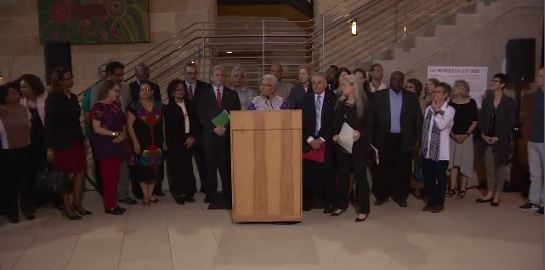City leaders discuss legacy of segregation from 1928 plan
Tuesday, March 20, 2018 by
Jack Craver At a press conference at City Hall on Monday, city leaders and activists recognized the 90th anniversary of Austin’s first zoning code, which enshrined legal segregation by race and ethnicity.
The 1928 Master Plan was most notable for establishing the former East Avenue, which has since been replaced by Interstate 35, as a dividing line between “white Austin” and “black Austin.” The city pressured African-Americans who lived west of that boundary to move east by refusing to hook up their homes to utility lines and prohibiting them from accessing public services in the area, including parks and schools.
The legacy of the 1928 plan has remained visible in Austin decades after it and other segregationist laws were upended by court rulings and civil rights legislation in the 1950s and ’60s. The city is still deeply segregated by race and class.
Council Member Ora Houston, City Council’s only African-American member, described growing up attending segregated schools in East Austin and rattled off the decisions taken by local authorities following official desegregation that kept children largely separated by race. She noted the end of busing and the establishment of a “neighborhood schools” policy by the Austin Independent School District in 1986 as ensuring continued segregation.
“In my community that’s called ‘separate but unequal,’” she said, “because the racial segregation lines had been established in 1928.”
Mayor Steve Adler implored the community to acknowledge and confront the segregation and racial inequities that persist in Austin.
“We cannot be a great city if we do not confront these truths about ourselves,” he said.
Former state Sen. Gonzalo Barrientos described his childhood in Bastrop, where he attended a Latino-only school for first grade before the town began in the late 1940s to allow Mexican-Americans to attend white schools. African-Americans, he noted, continued to be excluded.
Barrientos later worked as a community organizer for the Urban League, where he said he was inspired by his boss, Thelma Elliott. “It was the mom of this lady here,” he said, motioning to Houston, who wiped tears from her eyes.
Although nobody speaking at the conference made any arguments about how the city could address racial inequality through its new Land Development Code, the shadow cast by CodeNEXT over the event was unmistakable. Robin Rather, a former chair of the Save Our Springs Alliance, decried “Smart Growth” policies put in place in the 1990s that she blamed for displacing minority residents.
In an op-ed piece on March 7, Houston herself drew parallels between the proposed new code and the one approved 90 years ago: “The major impact of both plans is the same: minorities and the less affluent lose their property and homes today and their opportunity to build wealth for tomorrow.”
Others in the community and on Council have argued the precise opposite: that restrictive zoning regulations supported by Houston and others opposing CodeNEXT drive racial and economic segregation by making large swaths of the city inaccessible to those without the means to buy an expensive, single-family home. Indeed, the three other minority members of Council – Council members Greg Casar, Delia Garza and Pio Renteria – have teamed up with Council Member Jimmy Flannigan in calling for the new code to reduce barriers to the construction of multifamily housing throughout the urban core.
At the event on Monday, however, Houston said she wanted the focus to be on remembering the 1928 plan, rather than talking about the current zoning debate. She pointedly rejected a question from a KUT reporter about how the city’s first plan relates to CodeNEXT.
The Austin Monitor’s work is made possible by donations from the community. Though our reporting covers donors from time to time, we are careful to keep business and editorial efforts separate while maintaining transparency. A complete list of donors is available here, and our code of ethics is explained here.
You're a community leader
And we’re honored you look to us for serious, in-depth news. You know a strong community needs local and dedicated watchdog reporting. We’re here for you and that won’t change. Now will you take the powerful next step and support our nonprofit news organization?



